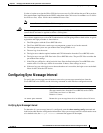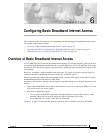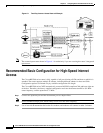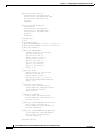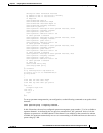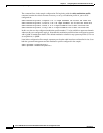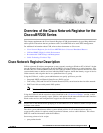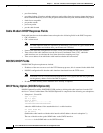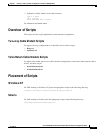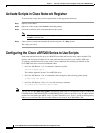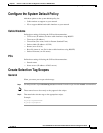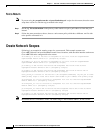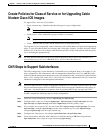
CHAPTER
7-1
Cisco uBR7200 Series Universal Broadband Router Software Configuration Guide
OL-2239-03
7
Overview of the Cisco Network Registrar for the
Cisco uBR7200 Series
This chapter supplements the Cisco Network Registrar (CNR) documentation by providing additional
cable-specific instructions that are pertinent to the CiscouBR7200series and CMTS management.
For additional information about CNR, refer to these documents on Cisco.com:
• Cisco Network Registrar for the Cisco uBR7200 Series Universal Broadband Routers
• CNR and DHCP FAQs for Cable Environment
• Recommended CNR Settings and Management
• Cable Technology Technical Tips
Cisco Network Registrar Description
CNR is a dynamic IP address management system, currently running on Windows NT or Solaris 2.6, that
uses the Dynamic Host Configuration Protocol (DHCP) to assign IP addresses to cableinterfaces, PCs,
and other devices on the broadband network. The CNR tool includes script extensions that allow a cable
system administrator to define and view individual DHCP options, define the identity or type of device
on the network, and assign the device to a predefined class or group.
Using the CNR tool, a cable system administrator can specify policies to provide:
• Integrated DHCP and Domain Name Server (DNS) services
• Time of Day (ToD) and Trivial File Transfer Protocol (TFTP) server based on the size of the network
• DHCP safe failover and dynamic DNS updates
Note This is available only in CNR 3.0 or higher.
Using the CNR tool and the extension scripts identified in the “Overview of Scripts” section, a cable
system administrator can specify scopes, policies, and options for the network and each cableinterface
based on the services and configuration to support at each subscriber site.
Note Scopes refer to the administrative grouping of TCP/IP addresses; all IP addresses within a scope should
be on the same subnet.
The cable system administrator defines system default policies for all standard options and uses
scope-specific policies for options related to particular subnets, such as cableinterfaces. This allows
DHCP to send the information with the IP address.
Seven entry points exist for scripts:
• post-packet-decode



